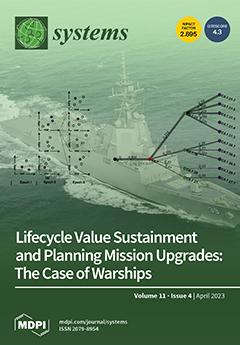In recent years, Model Based Systems Engineering (MBSE) has continued to develop as a standard for designing, managing, and maintaining increasingly complex systems. Unlike the document centric approach, MBSE puts the model at the heart of system design. Among the various MBSE language
[...] Read more.
In recent years, Model Based Systems Engineering (MBSE) has continued to develop as a standard for designing, managing, and maintaining increasingly complex systems. Unlike the document centric approach, MBSE puts the model at the heart of system design. Among the various MBSE language development efforts, “Systems Modeling Language (SysML)”, is the most anticipated and broadly utilized in the research and in industrial practice. SysML originated from Unified Modeling Language (UML) and follows the Object-Oriented Systems Engineering Method (OOSEM). SysML diagrams help users create various systems engineering artifacts, including requirements, use cases, operational concepts, system architecture, system behaviors, and parametric analyses of a system model. In the early days of implementation, MBSE languages, including SysML, typically relied on static viewpoints and limited simulation support to depict and analyze a system model. Due the continuous improvement efforts and new implementation approaches by researchers and organizations, SysML has advanced vastly to encompass dynamic viewpoints, in-situ simulation and enable integration with external modeling and simulation (M&S) tools. Virtual Reality (VR) has emerged as a user interactive and immersive visualization technology and can depict reality in a virtual environment at different levels of fidelity. VR can play a crucial role in developing dynamic and interactive viewpoints to improve the MBSE approach. In this research paper, the authors developed and implemented a methodology for integrating SysML and VR, enabling tools to achieve three dimensional viewpoints, an immersive user experience and early design evaluations of the system of interest (SOI). The key components of the methodology being followed in this research paper are the SysML, a VR environment, extracted data and scripting languages. The authors initially developed a SysML for a ground-based telescope system following the four pillars of SysML: Structure, Requirements, Behavior and Parametrics. The SysML diagram components are exported from the model using the velocity template language and then fed into a virtual reality game engine. Then, the SysML diagrams are visualized in the VR environment to enable better comprehension and interaction with users and Digital Twin (DT) technologies. In addition, a VR simulation scenario of space objects is generated based on the input from the SysML, and the simulation result is sent back from the VR tool into the model with the aid of parametric diagram simulation. Hence, by utilizing the developed SysML-VR integration methodology, VR environment scenarios are successfully integrated with the SysML. Finally, the research paper mentions a few limitations of the current implementation and proposes future improvements.
Full article





